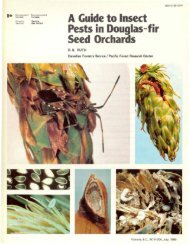Pacific Forestry Centre, Canadian Forest Service 506 West Burnside ...
Pacific Forestry Centre, Canadian Forest Service 506 West Burnside ...
Pacific Forestry Centre, Canadian Forest Service 506 West Burnside ...
You also want an ePaper? Increase the reach of your titles
YUMPU automatically turns print PDFs into web optimized ePapers that Google loves.
.<br />
s<br />
e<br />
e<br />
S<br />
ts<br />
y<br />
r<br />
of<br />
nt<br />
ch<br />
m<br />
es<br />
sS<br />
mgle<br />
lance<br />
l-rich<br />
table<br />
:ritish<br />
'oject<br />
n.d.).<br />
:-X-383<br />
;:}<br />
f<br />
i<br />
<br />
<br />
I<br />
<br />
I<br />
I<br />
I<br />
I<br />
I<br />
<br />
information to complement large-scale studies of<br />
C fluxes and stocks, and the associated modeling<br />
exercises. The NMR studies analyzed peats with<br />
various degrees of decomposition as assessed by<br />
other techniques, and there do not appear to be<br />
any NMR or molecular-level analyses of timecourse<br />
decomposition studies, not even to<br />
characterize the starting materials.<br />
Climate change issues have recently stimulated<br />
much research on C stocks and fluxes in<br />
peatlands, including C isotope studies. However,<br />
this has not been accompanied by corresponding<br />
advances in C chemistry. Recent studies of<br />
decomposition have focused on environmental<br />
controls of mass loss, with assessment of substrate<br />
quality largely restricted to C and N contents<br />
(Farrish and Grigal 1988; Braeke and Finer 1990;<br />
Johnson and Damman 1991; Szumigalski and<br />
Bayley 1996; Thormann and Bayley 1997; Latter et<br />
al. 1998; Hartmann 1999; Scheffer and Aerts 2000;<br />
Thormann et al. 2001). Two studies of peat soils<br />
(rather than fresh litter) showed the importance of<br />
distinguishing different pools of C and also the<br />
limitations of PA to explain C, N, and P<br />
mineralization (Updegraff et al. 1995; Bridgham et<br />
al. 1998); by contrast the simple von Post measure<br />
of decomposition was more successful.<br />
Liihdesmiiki and Piispanen (1988) examined<br />
sequences of fresh leaves, litter, and humus<br />
through PA and enzyme activity. Very narrowly<br />
focused studies of enzyme activities (Pind et al.<br />
1994, Freeman et al. 1996) culminated in the claim<br />
that limited activity of one enzyme - phenol<br />
oxidase - could be the controlling factor for C<br />
storage in peat (Freeman et al. 2001).<br />
Compared with the efforts expended for<br />
forests, grasslands, and agriculture, there has been<br />
little detailed process work on C flows and<br />
transformations in wetlands. Some recent studies<br />
used carbon-14 labeling to track the fate of C from<br />
litter (Domish et al. 2000) and recently assimilated<br />
C (Richart et al. 2000). The metabolic pathways of<br />
13C-Iabeled glucose were followed with varying<br />
pH, temperature, and redox conditions (Bergman<br />
et al. 1999; Bergman et al. 2000). Van den Pol-van<br />
Dasselaar and Oenema (1999) determined<br />
methane and carbon dioxide (C02) production<br />
from size and density fractions of peat.<br />
Factors controlling production of C02,<br />
methane, and DOC have been examined by Moore<br />
and Dalva (1997, 2001) and by Scanlon and Moore<br />
In! Rep. NOR-X-383<br />
(2000); the latter found that CO2 production was<br />
best correlated with the von Post index of<br />
decomposition. Other recent research indicates<br />
that the radiocarbon age of peatland DOC may<br />
differ from that of the bulk peat, and that the<br />
complexities of DOC formation and movement<br />
require further investigation (Aravena et al. 1993;<br />
Bellisario et al. 1999; Chasar et al. 2000; Kracht and<br />
Gleixner 2000; Palmer et al. 2001). Compared with<br />
our understanding of DOC in forest soils<br />
(Guggenberger and Zech 1993, 1994; Kaiser et al.<br />
2000), there has been very little chemical investigation<br />
of DOC from peatlands (Kracht and<br />
Gleixner 2000).<br />
While environmental factors exert the<br />
primary control, substrate quality secondarily<br />
influences decomposition (Preston et al. 2000) and<br />
associated releases of dissolved and gaseous<br />
products. Its influence may be more important<br />
where decomposition is hindered by unfavorable<br />
environmental conditions. Addressing the<br />
significant current questions on C stocks and<br />
fluxes in peatlands, especially in Canada's boreal<br />
regions, requires an interdisciplinary approach to<br />
examine the relevant C chemistry with the<br />
appropriate analytical tools.<br />
References<br />
Aravena, R.; Warner, B.G.; Charman, D.J.; Belyea, L.R.; Mathur,<br />
S.P.; Dine!, H. 1993. Carbon isotopic composition of deep<br />
carbon gases in an ombrogenous peatland, northwestern<br />
Ontario, Canada. Radiocarbon 35:271-276.<br />
Baas, M.; Pancost, R.; van Geel, B.; Damste, J.s.S. 2000. A<br />
comparative study of lipids in Sphagnum species. Org.<br />
Geochem. 31:535--541.<br />
Baldock, J. A.; Preston, C.M. 1995. Chemistry of carbon<br />
decomposition processes in forests as revealed by solidstate<br />
13C nuclear magnetic resonance. Pages 89-117 in<br />
Carbon forms and functions in forest soils. W.W. McFee<br />
and J.M. Kelly, eds. Soil Science Society of America,<br />
Madison, WI.<br />
Bates, A.L.; Hatcher, P.G.; Lerch, H.E., Ill; Cecil, c.B.; Neuzil,<br />
S.G.; Supardi, X.G. 1991. Studies of a peatified<br />
angiosperm log cross section from Indonesia by nuclear<br />
magnetic resonance spectroscopy and analytical<br />
pyrolysis. Org. Geochem. 17:37-45.<br />
Bellisario, L.M.; Bubier, J.L.; Moore, T.R.; Chanton, J.P. 1999.<br />
Controls on Clf. emissions from a northern peatland.<br />
Glob. Biogeochem. Cycles 13:81-89.<br />
Bergman, 1.; Lundberg, P.; Nilsson, M. 1999. Microbial carbon<br />
mineralization in an acid surface peat: effects of<br />
33



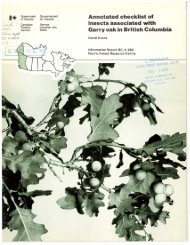
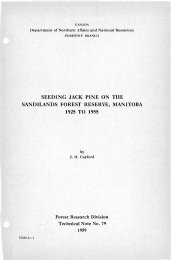
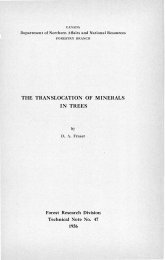


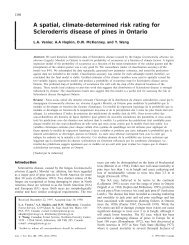

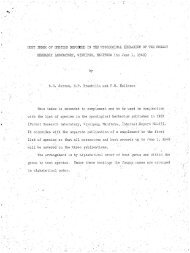
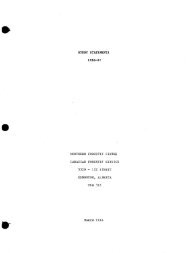
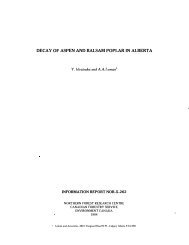
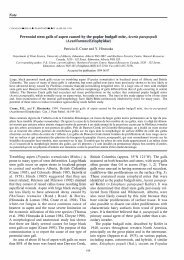
![Po],rell](https://img.yumpu.com/11946277/1/190x231/porell.jpg?quality=85)
